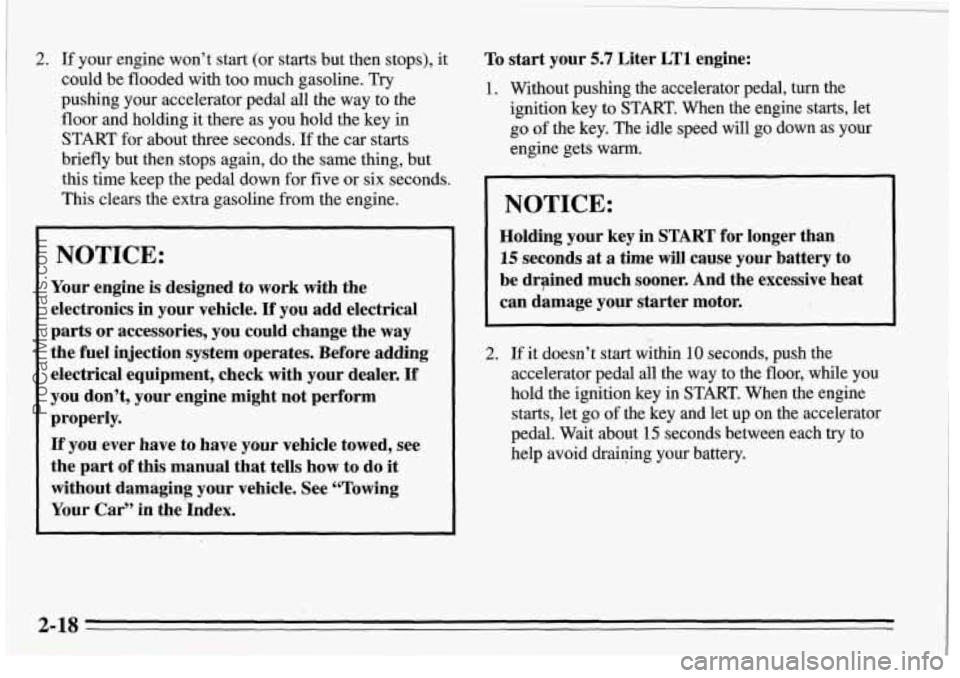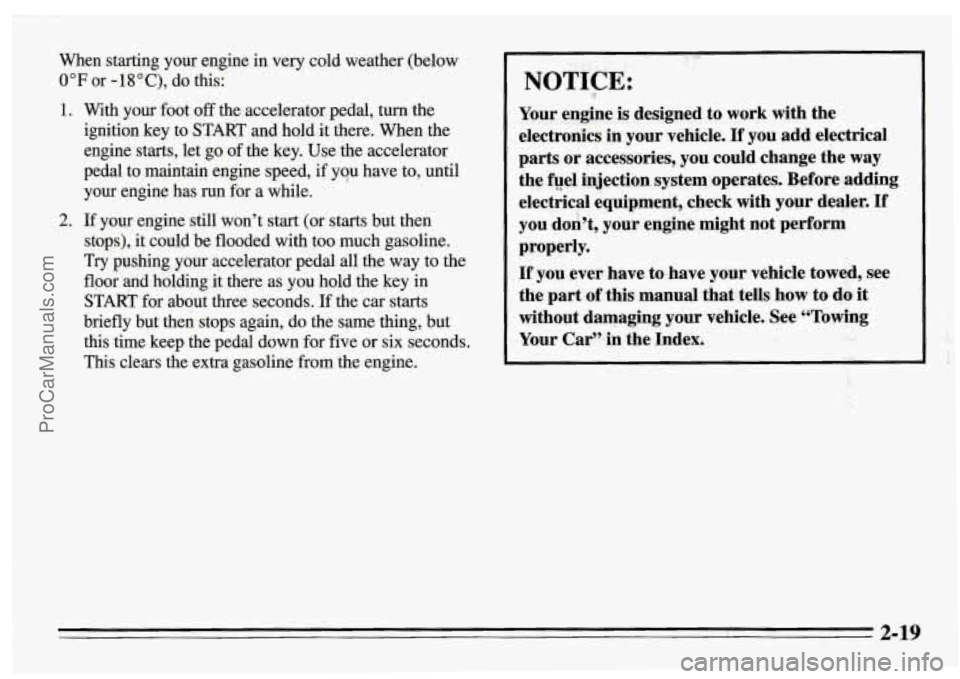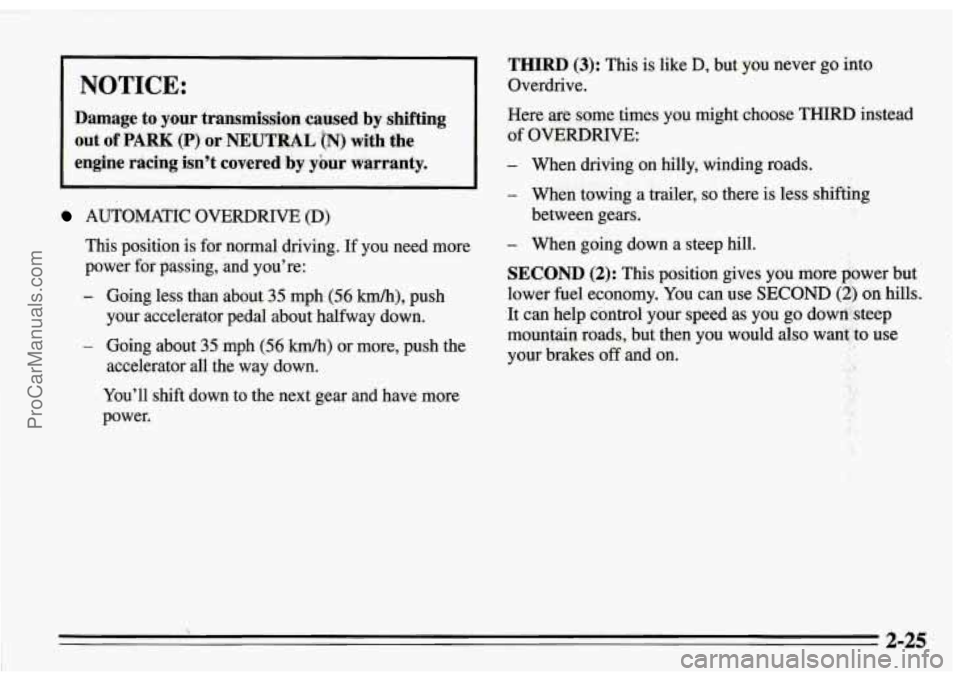towing PONTIAC FIREBIRD 1995 Owners Manual
[x] Cancel search | Manufacturer: PONTIAC, Model Year: 1995, Model line: FIREBIRD, Model: PONTIAC FIREBIRD 1995Pages: 386, PDF Size: 19.66 MB
Page 61 of 386

New Vehicle “Break-In” Ignition Switch
NOTICE:
Your modern Pontiac doesn’t need an elaborate
%break-in.” But it
will perform better in the long
run
if you follow these guidelines:
0
0
0
0
Keep your speed at 55 mph (88 km@) or
less for the first
500 miles (804 km).
Don’t drive at any one speed
-- fast or slow
-- for the first 500 miles (804 km). Don’t
make full-throttle starts.
Ayoid making hard stops for the first
2a0: miles (322 kni) or so. During this time
your new brake linings aren’t yet broken
in. Hard stops with new linings can mean
premature wear and earlier replacement.
Follow this “breaking-in” guideline every
time you get new brake linings.
Don’t tow a trailer during “break-in.” See
“Towing a Trailer” in the Index for more
information.
With the ignition key in the ignition switch, you can turn
the switch to five positions:
ACC (A): Position in which you can operate your
electrical power accessories. Press in the ignition switch as you
turn the top of it toward you.
LOCK (B): The only position in which you can remove
the key. This locks your steering wheel, ignition and
automatic transmission.
2-14
ProCarManuals.com
Page 65 of 386

2. If your engine won’t start (or starts but then stops), it
could be flooded with too much gasoline. Try
pushing your accelerator pedal all the way to the
floor and holding it there as you hold the key in
START for about three seconds. If the car starts
briefly but then stops again, do the same thing, but
this time keep the pedal down for five or six seconds.
This clears the extra gasoline from the engine. ~ ~
NOTICE:
Your engine is designed
to work with the
electronics in your vehicle.
If you add electrical
parts or accessories9 you could change the
way
the fuel in&tion system operates. Before adding
electrical equipment, check with your dealer.
If
you don’t, your engine might not perform
properly.
If you ever have to have your vehicle towed, see
the part
of this manual that tells how to do it
without damaging your vehicle. See “Towing
Your Car” in the ‘Index.
To start your 5.7 Liter LT1 engine:
1. Without pushing the accelerator pedal, turn the
ignition key to START. When the engine starts, let
go
of the key. The idle speed will go down as your
engine gets
warm.
I
NOTICE:
Holding your key in START for longer than
15 seconds at a time will cause your battery to
be drained much sooner. And the excessive heat
can damage your starter motor.
2. If it doesn’t start within 10 seconds, push the
accelerator pedal all the way to the floor, while you
hold the ignition key in START. When the engine
starts, let go
of the key and let up on the accelerator
pedal. Wait about
15 seconds between each try to
help avoid draining your battery.
2-18
ProCarManuals.com
Page 66 of 386

When starting your engine in very cold weather (below
0°F or -18"C), do this:
1. With your foot off the accelerator pedal, turn the
ignition key to START and hold it there. When the
engine starts, let
go of the key. Use the accelerator
pedal to maintaiq engine speed, if you have to, until
your engine has run for
a while.
stops), it could be flooded with too much gasoline.
Try pushing your accelerator pedal all the way to the
floor and holding it there as you hold the key in
START for about three seconds. If the
car starts
briefly but then stops again,
do the same thing, but
this time keep the pedal down for five or six seconds.
This clears the extra gasoline from the engine.
2. If your engine still won't start (or starts but then
' NOTICE:
- Ir
7
Your engine is designed to work with the
electronics in your vehicle.
If you add electrical
parts or accessories, you could change the
way
the fuel injection system operates. Before adding
electrical equipment, check with your dealer.
If
you don't, your engine might not perform
properly.
If you ever have to have your vehicle towed, see
the part of this manual that tells how to do
it
without damaging your vehicle. See "Towing
Your Car" in the Index.
' 4+
2-19
ProCarManuals.com
Page 72 of 386

NOTICE:
THIRD (3): This is like D, but you never go into
Overdrive.
Damage to your transmission caused by shifting Here are some times you might choose THIRD instead
out of PARK (P) or NEUTRAL [N) with the of OVERDRIVE:
engine racing isn’t covered by your warranty. - When driving on hilly, winding roads.
- When towing a trailer, so there is less shifting
AUTOMATIC OVERDWE (D) between gears.
This position is for normal driving. If you need more
power for passing,
and you’re:
- Going less than about 35 mph (56 kmk), push
your accelerator pedal about halfway down.
- Going about 35 mph (56 kmk) or more, push the
accelerator all the way down.
You’ll shift down to the next gear and have more
power.
- When going down a steep hill.
SECOND (2): This position gives you more power but
lower fuel economy.
You can use SECOND (2) on hills.
It can help control your speed as you go dowri-:.steep
mountain roads, but then you would also want-to use
’,
your brakes off and on.
4
!
1
I
ProCarManuals.com
Page 80 of 386

If you are towing a trailer and are parking on any
hill: See“Towing a Trailer” in the Index. That section
shows what to
do first to keep the trailer from moving.
To release the parking brake:
L
Hold the brake pedal down. Pull the parking brake lever
up until you
can push in the release button. Hold the
release button in as you move the brake lever all the way
down.
NOTICE:
Driving with the parking brake on can cause
your rear brakes to overheat.
You may have to
replace them,
and you could also damage other
parts
of your vehicle.
2-33
ProCarManuals.com
Page 83 of 386

Shiftiqg out of PARK (P)
(Authmatic .. .. Transmission)
Parking Your Vehicle
(Manual Transmission)
Your Pontic has a brake-transmission shift interlock. Before you get out of your vehicle, put your manual
You hqve to hlly apply your regular brake before you transmission in REVERSE (R) and firmly apply the
ca~ shjft from PARK (P) when the ignition is in the parking brake.
RUN position. See “Automatic Transmission” in the
Index.
If yov cmot shift out of PARK (P), ease pressure on
the shift lever - push the shift lever all the way into
PARK (P) and release the shift lever button as you
maintain brake application. Then press the shift lever
button
and move the shift lever into the gear you wish.
If you per hold the brake pedal down but still can’t
shift out
of PARK (P), try this:
1. Turn @e key to OFF.
If your vehicle is equipped to tow a trailer, see “Towing
a Trailer” in the Index.
2, Apply and hold the brake.
3. Shift to NEUTRAL (N).
4. St& the vehicle and then shift to the drive gear you
5. Have the vehicle fixed as soon as you can,
ww!.
ProCarManuals.com
Page 85 of 386

Running Your Engine While You’re
Parked (Automatic Transmission)
It’s better not to park with the engine running. But if you
ever have to, here are some things to know.
Follow the proper steps to be sure your vehicle won’t
move. See “Shifting Into
PARK (P)” in the Index.
If you are parking on a hill and if you’re pulling a
trailer, also see “Towing a Trailer” in the Index.
2-38
ProCarManuals.com
Page 116 of 386

Brake System Warning Light
Your Pontiac’s hydraulic
B RAKE two parts. If one part isn’t
brake system is divided into
working, the other part can
still work and stop you. For
good braking, though, you
need both parts working
If the warning light comes on, there could be a brake
problem. Have your brake system inspected right away.
This light should come on briefly as you start the
vehicle. If it doesn’t come
on then, have it fixed so it
will be ready to warn you if there’s a problem.
If the light comes on while you are driving, pull off the
road and stop carefully. You may notice that the pedal is
harder to push. Or, the pedal may
go closer to the floor.
It may take longer to stop. If the light is still on, or if the
anti-lock brake system warning light is flashing, have
the vehicle towed for service. (See “Anti-Lock Brake
System Warning Light” and “Towing Your Car” in the
Index.)
The brake system warning light will also come on when
you set your parking brake, and it will stay on if your
parking brake doesn’t release fully. If it stays on after
your parking brake is fully released, it means you have a
brake problem.
2-69
ProCarManuals.com
Page 117 of 386

Anti-Lock Brake System Warning Light
ABS
INOP
With the anti-lock brake system, this light will come on when
you
start your engine and it will stay on for three seconds.
That’s normal.
If the light doesn’t come on, have it fixed so it
will be ready
to warn you if there is a problem.
If the light flashes when you’re driving, you don’t have
anti-lock brakes and there could be a problem with your
regular brakes. Pull
off the road and stop carefully. You
may notice that the pedal is harder to push. Or, the pedal
may go closer to the floor. It may take longer to stop.
Have the vehicle towed for service. (See “Towing Your
Car” in the Index.)
If the anti-lock brake system warning light stays on
longer than normal after you’ve started your engine, turn
the ignition off. Or, if the light comes on and stays on
when you’re driving, stop as soon as possible and
tum
the ignition off. Then start the engine again to reset the
system.
If the light still stays on, or comes on again
while you’re driving, your Pontiac needs service.
If the
light
is on but not flashing and the regular brake system
warning light isn’t
on, you still have brakes, but you
don’t have anti-lock brakes.
2-70
ProCarManuals.com
Page 182 of 386

Towing a Trailer
I NOTICE:
Pulling a trailer improperly can damage your
vehicle and result in costly repairs not covered by
your warranty.
To pull a trailer correctly, follow
the advice in this part, and see your Pontiac
dealer for important information about towing
a
trailer with your vehicle.
4-31
ProCarManuals.com